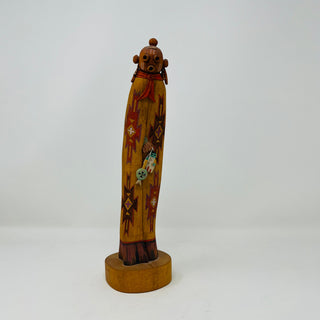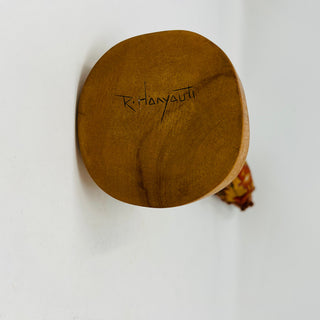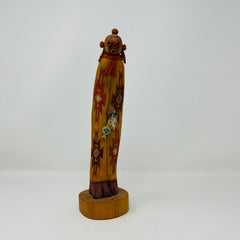"Koyemsi" or Mudhead Kachinas are likely the most well known of the Hopi kachinas, and they appear in almost every Hopi ceremony. Koyemsi Kachina, is a clown who may be seen in most Hopi ceremonies. Mudhead Kachinas drum, dance, play games with the audience, and may act as announcers for events. They often give prizes or rewards for the races and guessing games they organize.
This kachina was hand-carved and painted by Ronald Honyouti. Ron Honyouti (1955-) is from Bacavi, Hotevilla, Third Mesa, AZ. He has been carving since the early 1970s and has more awards than he can count. His favorite figures include the Longhair and the Crow Mother. He lives in the rhythm of Hopi life.
- Signed by artist on the base
- Condition: excellent; no damage
- Size: 12" with base
- Vintage: SOLD-AS-IS
Central to Hopi religion, Kachinas are supernatural beings believed to live on the San Francisco Peaks near Flagstaff, Arizona. Hopi men embody the Kachina spirits during ceremonies that take place between Winter Solstice and mid-July. The Hopis believe these spirits enable them to live in harmony with nature, ensuring rain, crops, fertility, and good hunting. The Hopi men embody the spirits of these kachinas by wearing masks and dancing in the plazas of the villages.
Traditional, or Old-Style, Kachina Dolls were simple carvings, replicas of the dancers that would be visiting during the upcoming ceremony. These would be given to the children so that they may learn about their people's traditions.
The art of carving kachina dolls has evolved from the old-style blocklike figures into today's highly detailed, all-wood dolls with realistic form and action. Over time, Kachina Dolls became more and more sophisticated and included bases for the dolls to stand on and showing the Kachina in “action”- such as dancing or hunting.
All Kachina Dolls are carved out of the root of the Cottonwood tree. The Cottonwood tree’s vigorous roots travel far and deep in search of water. There is spiritual importance in this fact, as the Hopis are dry farmers in an arid part of Arizona and the search for water is of critical importance to their culture.
"Koyemsi" or Mudhead Kachinas are likely the most well known of the Hopi kachinas, and they appear in almost every Hopi ceremony. Koyemsi Kachina, is a clown who may be seen in most Hopi ceremonies. Mudhead Kachinas drum, dance, play games with the audience, and may act as announcers for events. They often give prizes or rewards for the races and guessing games they organize.
This kachina was hand-carved and painted by Ronald Honyouti. Ron Honyouti (1955-) is from Bacavi, Hotevilla, Third Mesa, AZ. He has been carving since the early 1970s and has more awards than he can count. His favorite figures include the Longhair and the Crow Mother. He lives in the rhythm of Hopi life.
- Signed by artist on the base
- Condition: excellent; no damage
- Size: 12" with base
- Vintage: SOLD-AS-IS





